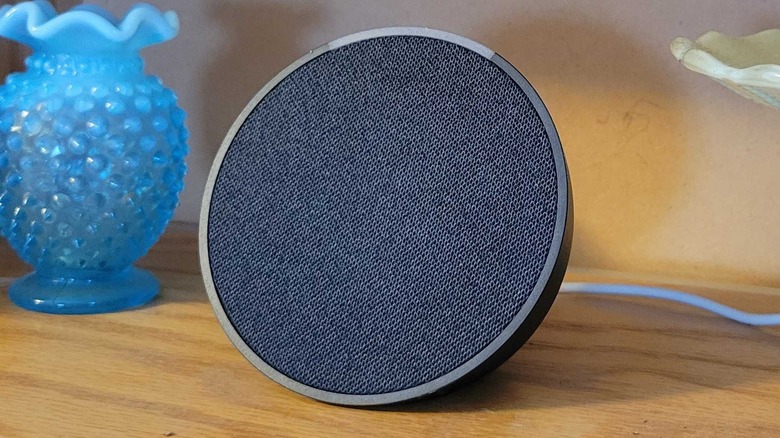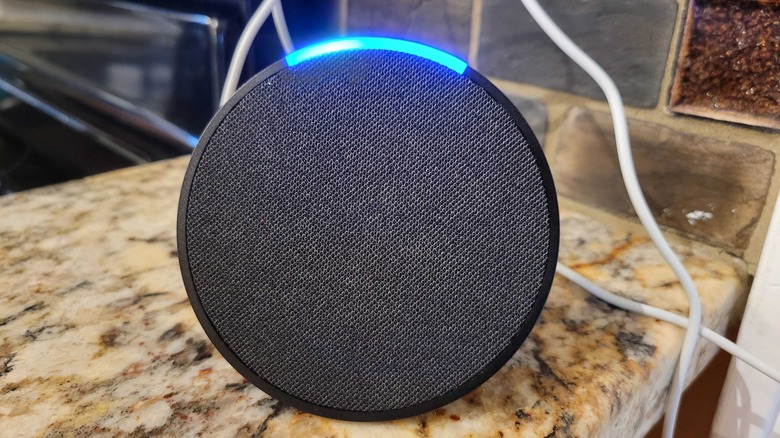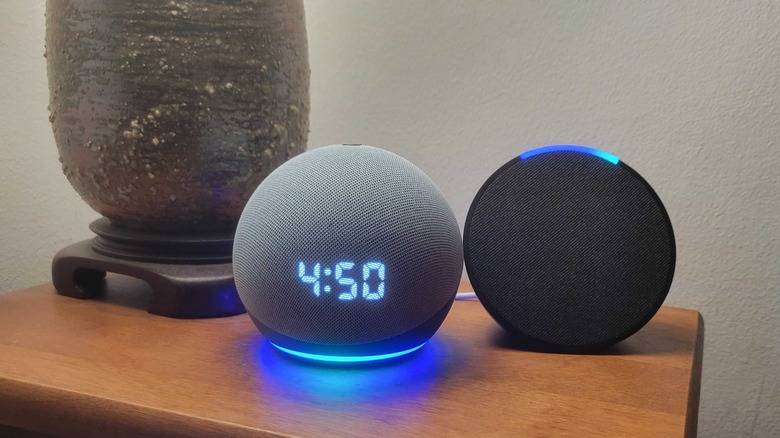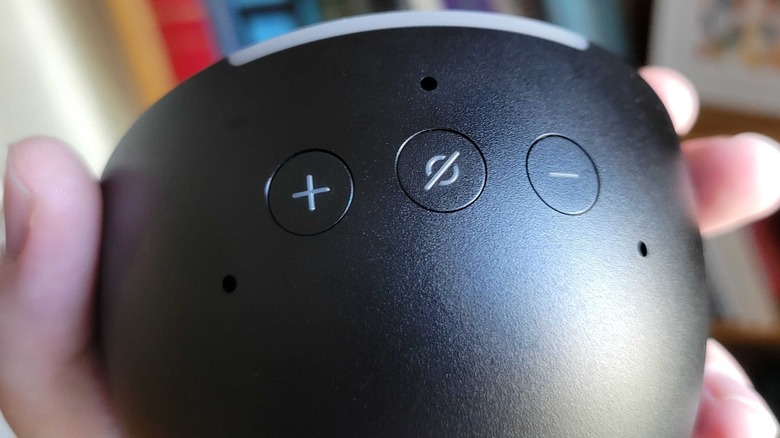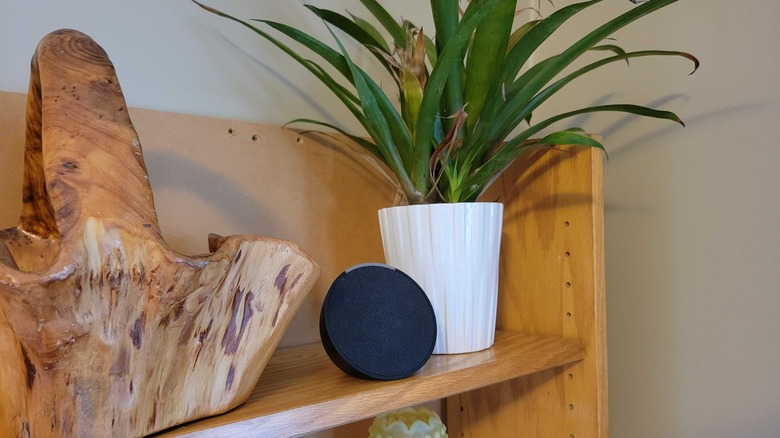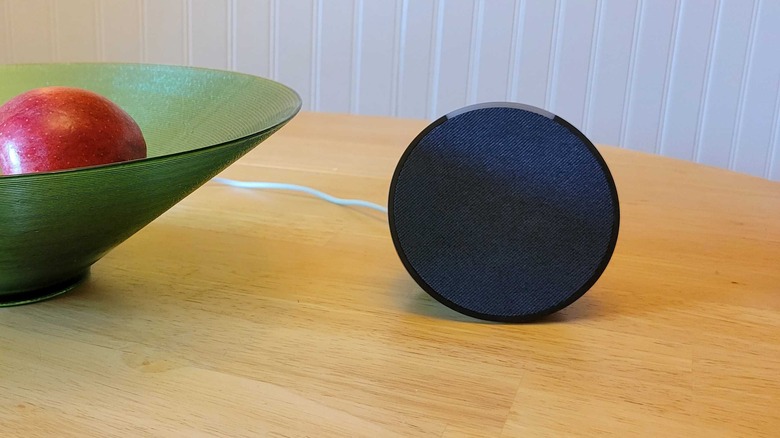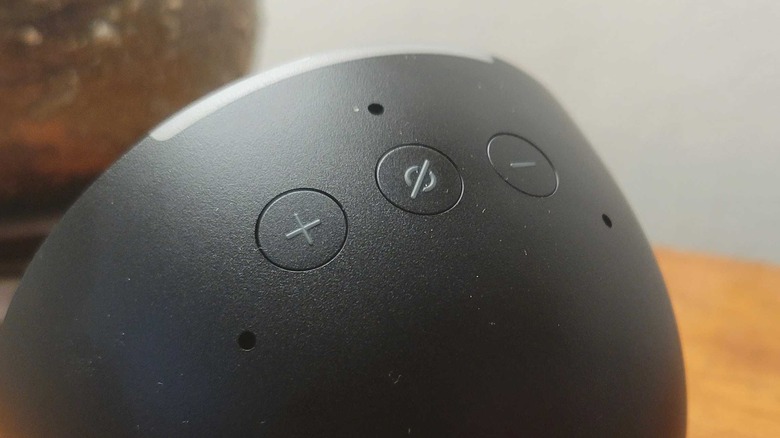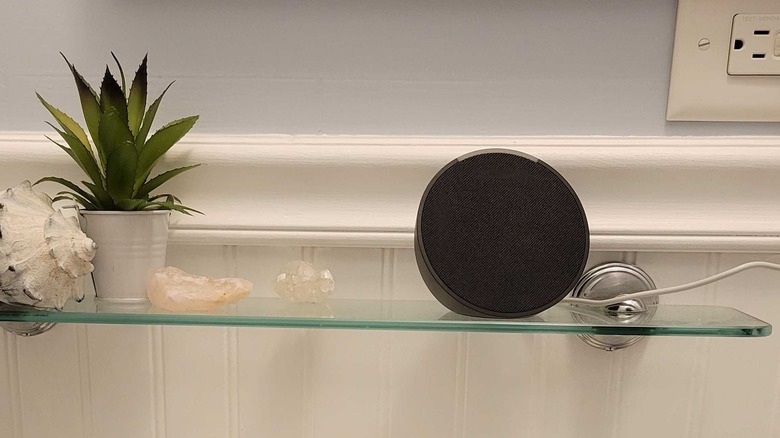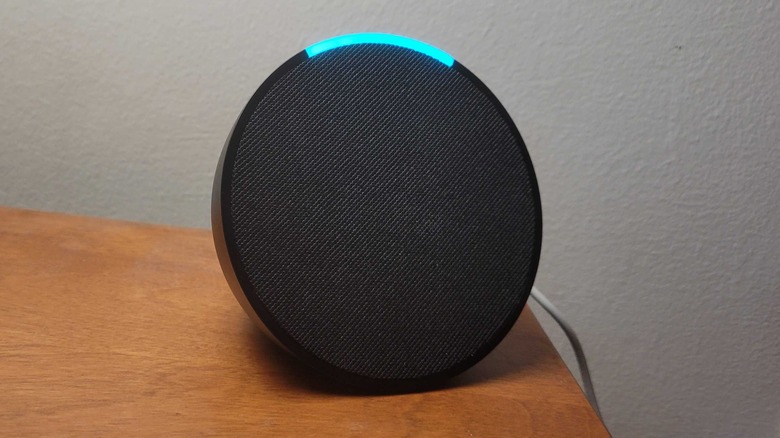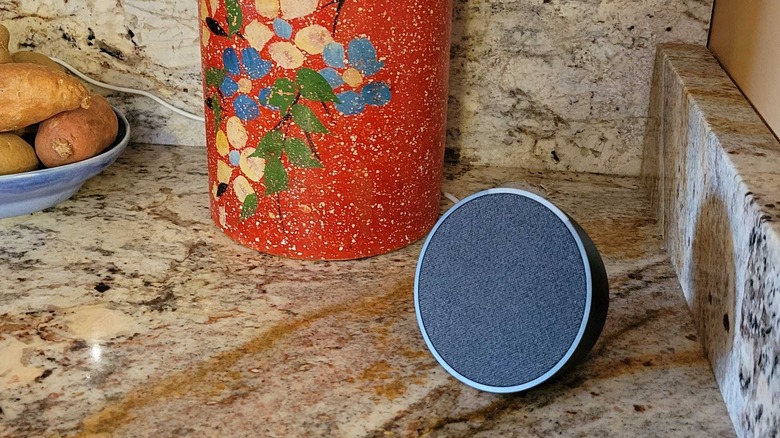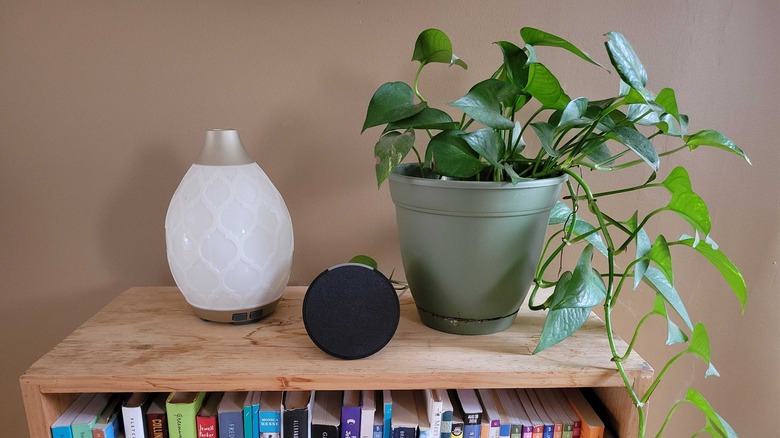Amazon Echo Pop Review: An Alexa Speaker That Looks Nice And Talks Back
- Directional audio is handy
- Matter ready
- Can function as a range extender for Eero Wi-Fi
- Inexpensive because it's part of a larger plan
- The buttons are awkward
- The sound isn't brilliant
- It has no LED display
We may receive a commission on purchases made from links.
You're probably aware of Amazon's Echo lineup. What started out as one towering smart speaker a few years back is now a series of speakers in a variety of shapes, a few devices with video displays, and a strange little thing you can clip into your car. The array of strangely shaped devices has just expanded with the Echo Pop, a new smart speaker that's shaped like half a coconut or a dimmed-out Bat Signal spotlight if you're imaginative enough.
Either way, it's a unique-looking addition to Amazon's smart speaker lineup and offers yet another option to people who are either building or expanding a smart home. It retails at around $40 if you're paying full price, and is similar to the Echo Dot lineup in terms of both price and features. If you're familiar with the Dot, you'll probably appreciate the numerous comparisons we've made throughout this piece. If you aren't, you should probably read up on the fourth and fifth generations of the device before making a purchase. Even if you like the sound of the Pop, and are intent on an Alexa-based smart home, they are both direct alternatives that should really be considered. Amazon provided us with an Echo Pop for the purposes of this review.
Setup was simple
While we've been critical of some Amazon products in the past, there is one thing they do exceptionally well. If you have a smartphone and the Alexa app installed on it, setting up an Echo Pop, or any other Echo product, is ridiculously simple — especially if your smart home network is already established.
We plugged in the Echo Pop we were sent to test, and it went into pairing mode. You'll know it's in pairing mode because an orange light will be blaring at you, as opposed to the blue light, which shows up when "Alexa" is thinking or listening, and the red light that pops up when something is wrong with the network. When the device is in pairing mode, you should open the Alexa app, click "devices," then the plus symbol in the top right corner. When the menu pops up click "add device," and then "echo." Your app will now prompt you to enable Bluetooth, the device will connect to the phone over that Bluetooth connection, and "Alexa" will handle the rest. If your preferred smart home Wi-Fi network is already linked to the app, then the app will fill in all of the details. We were all set up with minimal effort in a couple of minutes, though the process may take a bit longer if this is your first Amazon device.
It's missing a major feature from other Echo devices
If you've encountered a recent Echo Dot, the closest product to the Echo Pop, you'll notice one major difference. The Pop lacks any kind of LED display. So you won't see the time, any song titles flashing across the screen, or those little weather animations. This may seem like a minor difference at first, but it's massively inconvenient in a few settings.
In short, you don't want one of these in the bedroom and would be better off getting a "Dot" instead. Although it may seem minor, you'll really notice how often you look at the time on the bedside device until it's gone. You can still ask Alexa the time, and she will tell you, but this takes far more effort than just glancing at the Echo. This is also more of a problem at the bedside, as asking the time will probably wake someone up. If we had to guess, we'd say the next generation of this device will certainly come with an LED display.
The buttons aren't great
When you aren't using voice commands, you can rely on the limited number of buttons Echo devices have to perform some basic functions. These buttons can raise and lower the volume or mute the device's microphone if you're really worried about Alexa spying on you. What's missing from the Echo Pop is the "action" button, which wakes up the speaker in a similar way to its activation word. When it's present on other devices, the action button can also be used to put the device into setup mode. Dropping this button isn't necessarily a bad thing, in our experience, it's very rarely used and may have been somewhat of a waste of space. The mute and volume buttons have a far clearer purpose and likely see more use. The other buttons have their issues, though.
For a start, they're awkward to reach. On other Echo devices, you'll find them on top. As the pop is oddly shaped, they're sort of at the back and at an angle. This makes finding and pressing them difficult, and you could make the device slip or fall over. You can still disable the alarm by slapping the top of the alarm too, but this may also cause issues due to the Pop's distinct shape. Then there's a textural issue. The buttons are made from hard, almost sharp, plastic that is very unpleasant to prod.
It comes with Full Sound, whatever that means
A lot of the material that came with the Echo Pop and the press releases mention that the device "delivers full sound." It's not immediately apparent exactly what "full sound" is in terms of hard, cold facts. It's difficult to find any piece of text where Amazon actually explains it. There aren't any bits missing from the audio it plays, so it could be that.
What "Full Sound" certainly isn't is anything we haven't heard before from other Echo devices. The audio quality is about on par with any other Echo Dot or similar speaker that the company has released, and to our ears seems to be a touch lower than something like an Echo Show 5. It isn't bad, and it's more than adequate for things like audiobooks or playing some songs while you clean, cook, or work. Just don't expect the kind of high-fidelity experience that gets boring people in turtle necks stroking their chins and nodding. It's just "perfectly adequate," it isn't anything special. You may think the quality of the audio is the main thing a speaker should be judged on, but like other Echo devices, there are other factors to consider.
The sound is directional, which can be useful
The biggest difference between the speakers on the Pop and the speakers on an Echo Show is their directionality. Though they both technically have "front" facing speakers, the Pops are in a kind of cone. Because of how sound works, it's basically a wave that makes particles vibrate, the area in front of the echo pop will be a lot noisier than the parts directly to the side or behind it. This really pays off in things like apartments, where you may want to listen to something at an increased volume without absolutely ruining your neighbors' lives.
Don't expect magic though; you can still hear the Pop from behind, and from other rooms, just not anywhere near as loudly or clearly as you would if you were sat directly in front of it. Audio waves tend to bounce off things and come back at you. From the experiments we conducted during the testing period, we'd estimate that the pop sounds about half as loud to someone sitting directly behind it as it does to someone sitting directly in front of it while at medium volume. The difference diminishes the louder things get.
The microphones will pick up what you're saying
The device features three microphones, creating a "far-field" microphone array that is enough to pick up on voice commands in most circumstances. If you raise your voice slightly, you might be able to give Alexa a command from outside the room. Inside the room, the microphones are just as sensitive as anything in the current Echo range and you should be able to issue a voice request while speaking at a normal volume.
Alexa's "whisper" commands are still a touch hit and miss, though this could be more to do with the software than the hardware. While testing the whisper commands, of the commands that registered half resulted in Alexa issuing a whispered response, and the other half received a reply at full volume. We would flag this as an issue, but this is about the same ratio as you get with other current echo products. It doesn't seem to be the fault of the hardware. The same problem persists for people with any kind of accent. The microphones will pick up what you're saying just as clearly as anything else Alexa-related Amazon is currently selling, but what happens afterward relies on a roll of the digital dice. Maybe you'll get the song you want, maybe all of your lights will go out and your smart coffee maker will activate. Who knows?
Four colors are available
The test model Amazon sent out was "charcoal" or to be more specific, basically black. But you have more exciting options than that and the other traditional option, "glacier white," is also available. In what may be the most exciting selection of echos since they released the panda and tiger-themed versions a few years back, Amazon has announced four colors for the Echo Pop. The pop isn't directly aimed at children either, so you don't have to feel that weird pang of shame when you're just trying to have a bit of fun but your kart reminds you that you're buying something aimed at bringing joy into the lives of toddlers, not full grown adults.
But things go beyond black and white. The two additional colors are "Lavender Bloom," and "Midnight Teal." If you're wondering what any of that means, it's basically violet and turquoise. While these colors probably won't match with the rest of your Echo range, you're only really meant to have one of these in each room. The broader range of colors increases the odds of these blending in with a part of your home's color scheme. We're not hating on this, more options are never a bad thing.
The light bar has moved
Amazon's design team has shifted the light "bar" to the top of the Echo Pop, this is in contrast to the last few generations of Echo which light up around the bottom and closer to the earlier models which featured a halo of light on top of their hockey-puck like bodies. This is actually a good move on Amazon's part. The light is far smaller than it used to be, taking up a curved inch-and-a-half-long segment at the top of the device, but it's also far more noticeable.
As the Echo Pop is directional, it is likely to be at least vaguely facing you, but that doesn't really matter as far as the light is concerned. It's actually visible from all sides, though it is very small if you're looking at the Pop from either side as opposed to the front or the back. The top light is also great if your desk is cluttered, as things like books, candy bars, and even phones could obscure the base-based light other products in the Echo series tend to have. Earlier hockey-puck style echos also had a top light, but those were also a lot shorter. The Pop has a couple of inches on them, so you're far more likely to notice when Alexa is listening.
There are a couple of solid smart home features
If your home's Wi-Fi network is built on Amazon's Eero system, then the Echo Pop comes with a very useful extra perk. This will extend your home's Wi-Fi network by 1000 or so extra feet. As we didn't have an Eero-based Wi-Fi network on the testing premises, we couldn't test this aspect out. But according to Amazon, this will work with both the 2.4 GHz and 5 GHz bands.
This isn't great news for Wi-Fi 6e users, as extended coverage on the ultra-high-speed band would be very welcome. But as most current devices are still only 5 GHz or 2.4 GHz capable, the extended range is a huge bonus. The Echo Pop is dirt cheap, so you could easily have at least one per floor and end up with pretty much perfect Wi-Fi coverage throughout your home.
In addition to the other smart home features that come in the form of Alexa's capabilities, the Echo Pop is also "Matter ready." This essentially means you're going to have a far easier time connecting other devices to it once the smart home standard actually takes off.
It's pretty cheap, and will certainly get cheaper
The main thing most Amazon products have going for them is the price point at which they are sold. If we're comparing prices, the Echo Pop is around $10 cheaper than a standard Fifth-Gen Echo Dot. If you were to purchase this device on Amazon right now, $40 for a Matter-enabled smart speaker and Wi-Fi extender combo isn't really that bad. But let's be honest, very few people will be paying that.
Unless you've spent the last 20 years avoiding anything related to Amazon, you'll be aware that its in-house products rarely sell for their original full asking price. Most of the time, they have discounts in the region of 20% for no discernable reason beyond Amazon wanting you to buy one. A couple of times a year, such as during "Prime Day" events and Black Friday, these products receive ridiculous discounts which sometimes hit around 70%. It would not shock us if this speaker went on sale for under $20 in the coming months, and it may even end up hovering around the $15 mark. If you're looking for a smart speaker come July, and you spot this for under $20, buy it. Buy a couple. It isn't perfect but it's an absolute bargain at that price point.
As far as buying at full price goes, there's nothing about this that screams "buy one immediately." Still, if you really need to expand your smart home network ASAP, you could do a lot worse for the money.
